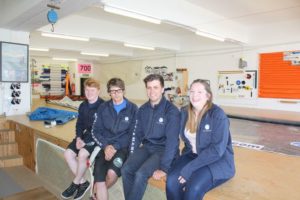Festival, floating restaurants and new park could revitalise River Wensum
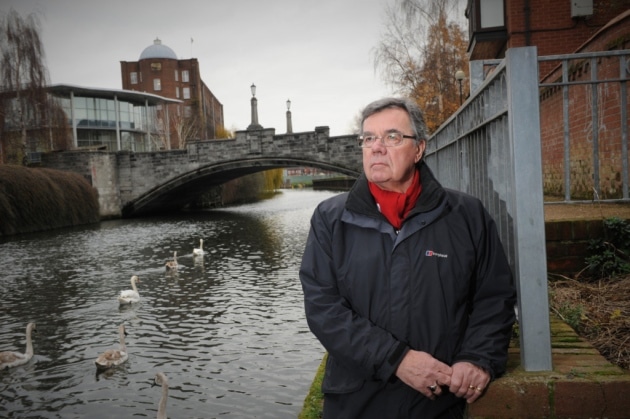
“At the moment, the city has turned its back on the river.”
So says Alec Hartley, of the Norwich Society and the Wensum River Parkway Partnership, whose long-standing call for a debate on how Norwich should make the most of the river finally looks like paying off.
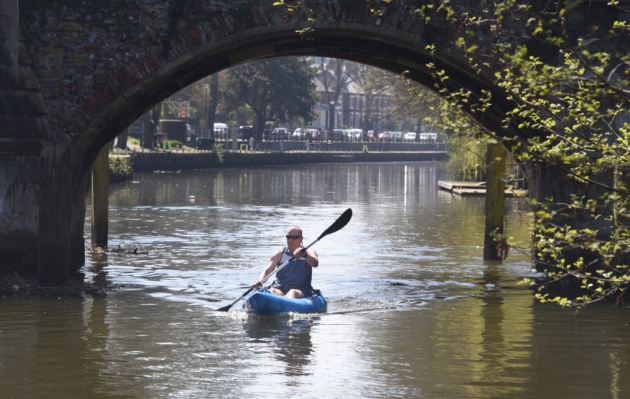
A kayaker goes under Bishop Bridge in the sunshine on the River Wensum. Picture: DENISE BRADLEY
City leaders are next week set to adopt the River Wensum Strategy – a vision for a revival of a river which was once at the heart of Norwich’s life and industry, but which has been neglected.
Among the proposals put forward in the strategy, which could happen over the next decade, are:
• A completed riverside walk from New Mills all the way to the Trowse swing bridge, including building the key ‘missing link’ of the walk between Duke’s Palace and St George’s Street.
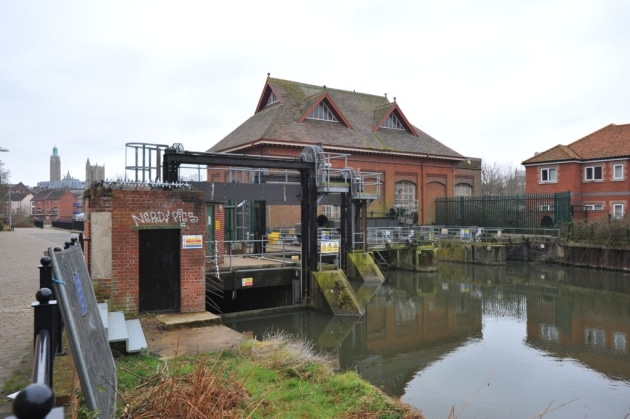
New Mills Yard in Norwich. PHOTO BY SIMON FINLAY
• Promotion of river events and tails, including a proposed river festival within the next couple of years.
• Improvements to the riverside walk further downstream from New Mills, with better signs connecting the river to key tourist sites.
• Encouragement for more river-based businesses, such as floating restaurants.
• A drive to make water quality better, including by trying to reduce the levels of oils and fats getting into the river from food businesses in the Magdalen Street/Fye Bridge Street area.
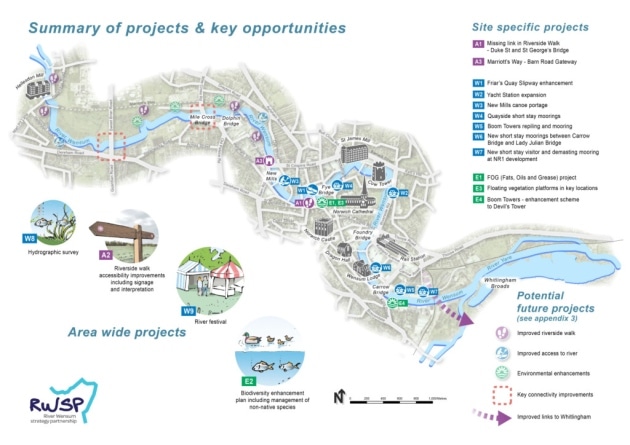
The projects which the River Wensum Strategy proposed. Pic: River Wensum Strategy Partnership.
• Floating vegetation platforms in parts of the river where there is little or no bankside vegetation.
• Better moorings for boats, including at the yacht station, Quayside and between Carrow Bridge and Lady Julian Bridge.
• The river opened up in a way it never has before, with better access, including for canoeists.
• Enhanced open spaces next to it, such as at the Boom Towers and the Devil’s Tower near Carrow Bridge, with the possible creation of a new urban woodland park.
• More spots from which anglers can fish.
• In the longer term, outdoor swimming could return to Wensum Park and a ferry could be reinstated at Pulls Ferry.
The overall vision is to: “Breathe new life into the river by enhancing it for the benefit of all and increasing access to, and greater use of, this important asset.
“An enhanced river corridor, with its unique natural and historic environment, will once again play an important part in the growth and vitality of the city, strengthening the visitor economy and helping to give the city a competitive advantage in attracting inward investment.”
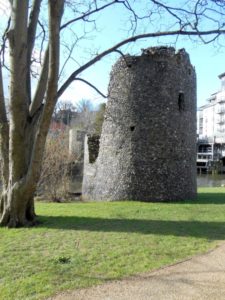
The Boom Tower near Carrow Bridge. Photo: The Norwich Society
The River Wensum Strategy has been years in the making, with calls as far back as 2011 for organisations such as the city council the Broads Authority, Environment Agency and Norfolk County Council to come together to forge a vision for the city.
The strategy which Norwich City Council’s cabinet is expected to adopt next Wednesday – and which will need to be adopted by other partners – is a culmination of work done by the River Wensum Strategy Partnership.
The strategy went out for consultation last year and amendments have been made based on what the public said, including a shift in emphasis to recognise the focus is not just on the city centre, but on the area beyond New Mills Yard.
A number of the projects are earmarked to be done over the next three years, to kickstart the 10-year strategy.
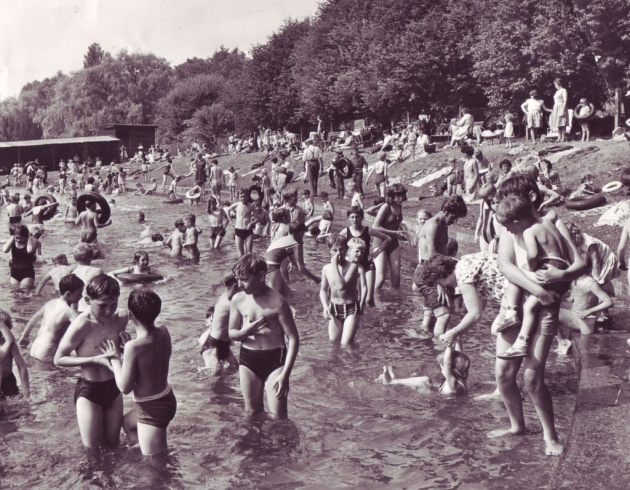
Youngsters take the plunge at Wensum Park, in a photograph from the archives. Pic: Archant.
A bid for funding for the river festival, which is seen as key to reconnect the city to the river through a string of events, has already been lodged with the Broads Authority.
But other projects will depend on other sources of money, such as cash from developers, Anglian Water and government grants.
Mr Hartley, a member of the strategy partnership, said breathing new life into the city was essential.
He says: “At the moment, the city has turned its back on the river.
“Historically speaking, it’s been a backwater, but it could be a huge asset in terms of the environment and tourism.
“It’s the reason there is a city here and it should be at the centre of the city.”
Mr Hartley acknowledged it had taken a number of years to get to this point, saying it was a “complex” issue.
But he said improvements had already been made during the drawing up of the strategy, including the installation of an eel pass by the Environment Agency at New Mills Yard.
Eels are a protected species and, before the pass was installed, they were unable to get through the yard, which is the tidal limit of the River Wensum.
Could outdoor swimming return to Wensum Park?
Outdoor swimming could one day return to Wensum Park as one of the longer-term aspirations of the strategy for the river.
The Grade II listed park once boasted an open-air swimming pool and children used to enjoy paddling in the river itself, via some concrete steps which led into the Wensum.
The outdoor pool, which was set back from the river was filled in and turned into a woodland area for wildlife. And the concrete steps which led to the paddling pool in the river have been covered with a boardwalk, although the park does still has a smaller paddling pool.
But, the strategy says the park has untapped potential. It moots the possibility of creating an access point to the river for canoes and for mooring points to be provided.
They also say: “In the longer term there may be potential to open up the site for swimming, subject to water quality issues being addressed.”
Could a ferry return to service at city landmark?
Pulls Ferry is one of the most photographed buildings in Norwich, but it has been more than 70 years since people could cross the river there. The flint building used to be called Sandlings, after an Elizabethan chorister who kept the ferry early in the 17th Century.
But the current name is in honour of John Pull, who ran the ferry across the Wensum from 1796 until 1841. After surviving an attempt to close it down by extending the railway along the river edge, which was defeated by the cathedral’s dean, the ferry continued to run until 1943.
One of the longer-term aspirations of the river strategy is to look into whether that ferry could run once more.
The report suggests that it could be worth investigating whether a small, pedestrian ferry could run across the Wensum at that point, primarily aimed at tourists visiting the city.
This story is from The Eastern Daily Press.


